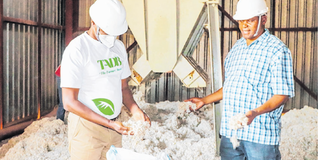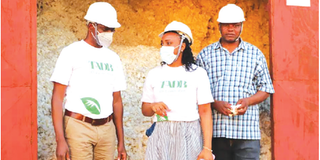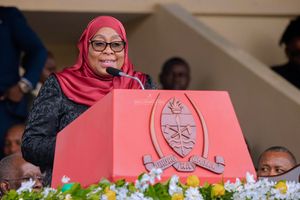TADB financing restores cotton sector to its glory days

TADB Managing Director, Frank Nyabundege (left) with Mbogwe Cooperative Union Chairperson, Benedicto Bulugu inspects cotton ready to be ginned at Mbogwe ginnery.
In the two seasons of the Tanzania Agricultural Development Bank (TADB) financing the ‘Cotton Value Chain’ farmers are able to sale their cotton at Tsh 1800 per Kg. “We farmers here in Mbogwe District have never thought of the day that cotton would be profitable like it has been in these two seasons. I can’t remember the last time my cotton was bought at even Tsh 1000, let alone now being at Tsh 1,800.” Explains Juma Magesa a cotton farmer.
According to TADB’s Policy brief Cotton is Tanzania’s third-largest export crop after cashew and coffee. The crop accounted for 14.5% of Tanzania’s total export earnings between 2005 and 2010. In 2016 alone, cotton accounted for 1.3% of all Tanzania’s exports, valued at US$ 63 million with main export destinations being Far Eastern countries (Bangladesh, China, Malaysia etc.), India, Europe and regional markets. At the micro-level, cotton provides a vital source of livelihood to around 40% of Tanzania’s population directly and indirectly employed in the sub-sector. At the macro level, the cotton sub-sector remains a key driver of Tanzania’s economy and holds great potential to contribute to the country’s industrial transformation.
“Understanding the importance of the Cotton value chain to our country’s economy, it was important for TADB to intervene and rescue the then dwindling sector. Considering the potentials in foreign currency the nation obtain from the export, the employment factor and need for improvement of livelihood among cotton farmers even steered TADB’s fast interventions for the sector.” Explained Frank Nyabundege Managing Director at TADB.
Financing ginneries through cooperative unions
Cotton ginning plays very important role in the cotton value chain. Ginning refers separation of cotton fibers and seeds from cottonseed and converts field crop into a saleable commodity known as lint. There are 87 ginneries in the Tanzania. By 2019, only 26 ginneries were active, with the rest either defunct or performing poorly.
Regional cooperative unions were re-introduced in the cotton sector in 1986. Their responsibilities included cotton production, the provision of seasonal credit, and ginning in their respective regions for as long as the unions themselves could access the necessary finance. Although cotton production reached record levels in the 1991 and 1992 harvest seasons a report by the World Bank identifies that many of the cooperative unions were soon beset with problems of corruption, poor management and, above all, financial mismanagement.
“Understanding this history has been very useful for TADB to examine the cotton players and inform us best on how we can intervene and rescue the sector successfully” Affirmed Mr. Nyabundege.
TADB adopted the farmer-centered approach to the industrialization of the cotton sub-sector based. The strategies included revival of cooperative unions’ cotton ginneries, Facilitating investments in cooperative unions’ cotton/ edible oil milling; and Facilitating investment in strategic warehouse facilities and the establishment of an efficient and transparent marketing system for cotton through the Tanzania Mercantile Exchange (TMX).

TADB Managing Director Frank Nyabundege (left), TADB Acting Director of Credit and Business, Afia Sigge (center) and Mbogwe Cooperative Union Chairperson, Benedicto Bulugu (right) in front of a warehouse that store cotton from farmers.
Recognizing the need for a proactive approach, TADB is implementing a phased plan which targets to revive 7 cooperative unions’ ginneries in the Lake Zone. These include Chato Cooperative Union (CCU) in Geita, Kahama Cooperative Union (KACU) in Shinyanga, Nyanza Cooperative Union (Manawa) in Mwanza, Pamba Mara Cooperative Union (Mugango) in Mara, and three Shinyanga Region Cooperative Union (SHIRECU) ginneries namely Sola and Lugulu in Simiyu and Masumbwe in Geita. The revival of the of the above mentioned ginneries is estimated to require capital investments to the tune of TZS 19.9 billion and working capital of TZS 80 billion.
“During the 1st Phase of the Plan, we proposed to revive 3 cooperative ginneries namely Chato Cooperative Union (CCU), Kahama Cooperative Union (KACU) and SHIRECU’s Mbogwe Ginnery (MBCU). A promise we have been able to realize with the recent beginning of ginning of Mbogwe Ginnery.” Confidently acclaimed Mr. Nyabugende.
TADB supporting the government efforts and the FYDP III
Recognizing this huge potential, the Government of Tanzania has been actively incentivizing farmers to increase the production of cotton through a shift to an AMCOS model of production. The model is expected to create greater organization and reduction of costs for individual farmers. “The government intervention through different ministries affirms the government commitment at creating an enabling environment to our cotton farmers.” Commented Mr. Nyabundege.
To date TADB has approved a total of TZS 41.9 billion to the cotton sector through the 3 Cooperative Unions (CCU, KCU &MBCU). The impact of TADB intervention has enabled creation of over 2,000 jobs along the value chain, increase of price from Tsh 814/ kg to 900/kg of 2019/20, Tsh 1,050/Kg of 2020/21 season to Tsh 1,800/Kg in the 2021/22 season. In 2020 price rose from and in 2021 price rose from 1,050/kg to 1,800/kg.
The TADB interventions to the cotton sub-sector sees aligning of the bank’s mandate in transforming the agricultural sector and further supporting the Five Year Development Plan phase three (FYDP III). The FYDP III has listed the priority areas of implementation that includes; Strengthening Industrial Production and Service Delivery Capacity, and Promoting Investment and Trade.
“As a government institution, we are committed at realizing our existence’s goal and furtherer the government agenda of industrialization economy. We believe that with revival of these ginneries and our intervention in other value chains, we can stimulate realization of the FYDP III.” Said Nyabugende.
TADB has revived three ginneries under three Cooperative Unions. The influence of the TADB intervention to the cotton sector has stimulated farmers’ price beyond indicative price for the two consecutive seasons.
Managing Director at TADB, Frank Nyabundege confirms that TADB interventions has been of benefit to not only farmers but also to the councils. “In the two seasons of TADB financing the sub-sector, councils have collected TZS 323million on cess, farmers have been paid total of 10.6 billion, TZS 311million has been paid as AMCOs levy.”


